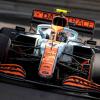McLaren mgu-k close up pictures and specs (link)
MGU-K Energy recovery
#51

Posted 12 February 2014 - 22:11
Advertisement
#52

Posted 17 February 2014 - 10:34
#53

Posted 17 February 2014 - 10:50
#54

Posted 17 February 2014 - 12:06
If you can save a lot of fuel that way, might we see races where everyone is fighting to be second so they can save as much fuel as possible with the intention of blasting past the leader late in the race? But the leader is going as slowly as possible to back them up before making a break for it? A bit like very expensive pursuit cycling? Or maybe more like stage cycling, with people breaking from the peloton and hoping they have judged it right? Even groups breaking and taking turns to lead to collectively preserve fuel while building a gap?
![]()
#55

Posted 17 February 2014 - 12:16
If you can save a lot of fuel that way, might we see races where everyone is fighting to be second so they can save as much fuel as possible with the intention of blasting past the leader late in the race? But the leader is going as slowly as possible to back them up before making a break for it? A bit like very expensive pursuit cycling? Or maybe more like stage cycling, with people breaking from the peloton and hoping they have judged it right? Even groups breaking and taking turns to lead to collectively preserve fuel while building a gap?
The only issue being of course that it's much harder to overtake in F1 than in cycling even with all of the overtaking aids, so that sort of strategy could backfire quite spectacularly.
#56

Posted 17 February 2014 - 12:22
The only issue being of course that it's much harder to overtake in F1 than in cycling even with all of the overtaking aids, so that sort of strategy could backfire quite spectacularly.
I was thinking of the flat out tracks with lots of straights where the 100kg fuel limit will be very tight and require fuel saving at some point.
It's obviously not going to help at the tight slow tracks, but at ones with lots of full throttle action, could it pay off to stay in second and draft down every straight, but lifting enough on the throttle so as not to overtake.
Towards the end of the race you might have saved enough to be able to go full throttle for the remaining laps while the guy ahead of you still has to fuel save.
#57

Posted 17 February 2014 - 12:23
The only issue being of course that it's much harder to overtake in F1 than in cycling even with all of the overtaking aids, so that sort of strategy could backfire quite spectacularly.
It wouldn't be too hard if you could run the last 30 laps at 100% and the car in front could only go at 80%. It's the ones behind you you'd have to be worried about.
Edited by oetzi, 17 February 2014 - 12:24.
#58

Posted 17 February 2014 - 12:27
I was thinking of the flat out tracks with lots of straights where the 100kg fuel limit will be very tight and require fuel saving at some point.
It's obviously not going to help at the tight slow tracks, but at ones with lots of full throttle action, could it pay off to stay in second and draft down every straight, but lifting enough on the throttle so as not to overtake.
Towards the end of the race you might have saved enough to be able to go full throttle for the remaining laps while the guy ahead of you still has to fuel save.
With the massive amount of drag these cars generate, even the slower tracks would have some potential for fuel saving by slipstreaming. I wonder if the 'retardation warning lights' were partly introduced with this possibility in mind?
#59

Posted 17 February 2014 - 12:41
If i understand right we could be looking at 860- 920 max HP in qualifying. 600- 650 from ICE, 100- 110 direct from H to K all wich is continious power .Plus 4MJ from ES at the maximum rate of 120Kw(161HP)
I think you've misunderstood a little. Max power will be ICE + 160bhp from MGH-K as this is the max output from the K unit. The confusion comes from the fact that you can run the K unit on power either from the MGU-H unit directly (up to about 100-120BHP) of from the energy Store (up to 160bhp) or a mixture of both (120 from the H and 4o from the ES). The amount of energy from the ES is limited to 4MJ (for both driving the K unit or for spooling up the turbo), but there is no limit to the amount of energy that can go direct from the H unit to the K unit.
Therefore if ICE numbers predicted are correct (I think most are saying approx 650bhp) then we should be looking at 810 max power (which isn't too shabby especially as the power band is much wider with the new power units)
Advertisement
#60

Posted 17 February 2014 - 13:12
So the amount power from MGU-K is limited by regulations at 120KW? I had missed that.Back to reading the regs for me:) Thanks!I think you've misunderstood a little. Max power will be ICE + 160bhp from MGH-K as this is the max output from the K unit. The confusion comes from the fact that you can run the K unit on power either from the MGU-H unit directly (up to about 100-120BHP) of from the energy Store (up to 160bhp) or a mixture of both (120 from the H and 4o from the ES). The amount of energy from the ES is limited to 4MJ (for both driving the K unit or for spooling up the turbo), but there is no limit to the amount of energy that can go direct from the H unit to the K unit.
Therefore if ICE numbers predicted are correct (I think most are saying approx 650bhp) then we should be looking at 810 max power (which isn't too shabby especially as the power band is much wider with the new power units)
#61

Posted 17 February 2014 - 15:15
Let's run a quick and dirty example with a generic F1 car. mass = 750 kg , height of CoG = 0.25m, wheelbase = 3.3 m, average deceleration = 3g
Our base car uses the 46/54% weight distribution, which means that it is carrying 345kg on the front and 405kg at the rear axle.
How is this looking when braking with 3g?
750*3*0.25/3.3 = 170 kg ( I will show it in mass units kg, to make it easier to follow, you can do the conversions to N if you like)
This means me have a load transfer of 170 kg @ 3g, our rear is getting 170 kg "lighter" while our front is getting "heavier".
front: 345kg + 170kg = 515kg 515/750 = 68.7 %
rear: 405kg - 170kg = 235kg 235/750 = 31.3 %
I believe you need to include downforce to this calculation. If an F1 car is decelerating at the rate of 3 G's, the axial loads will be quite a bit more than just the static weight & load transfer effect combined.
#62

Posted 17 February 2014 - 20:05
I was thinking of the flat out tracks with lots of straights where the 100kg fuel limit will be very tight and require fuel saving at some point.It's obviously not going to help at the tight slow tracks, but at ones with lots of full throttle action, could it pay off to stay in second and draft down every straight, but lifting enough on the throttle so as not to overtake.Towards the end of the race you might have saved enough to be able to go full throttle for the remaining laps while the guy ahead of you still has to fuel save.
In cycling you know with certainty that when you are drafting you will have an energy advantage relative to the guy in front. In F1, an active pursuit of this strategy will require an assumption that the guy in front is running at 100% while you are cruising behind and that he will in fact need to save fuel at some point. But in fact, how do you know? Maybe he has a second or two in his pocket and is cruising precisely to avoid any fuel isssues at the end of the race? Who knows. It's a bit like with tyres this year - you might think the guy in front of you is pushing and will run out of tyres on lap x, but then he just goes and goes and the drop off never comes when you expected it.
But my mind is very open. It may well be that someone will try and succeed in pulling off this maneuver - as you and oetzi say, fuel savings could well be quite considerable given the drag penalty. I very much look forward to finding out. And unlike the tyre situation, which was a bit of a lottery for each team where they had no idea when they would run into issues on their own car, let alone a car of the competitor, each team will know precisely its own fuel situation and will need to make calculated choices. That should make things quite interesting.
#63

Posted 17 February 2014 - 23:11
#64

Posted 17 February 2014 - 23:35
In cycling you know with certainty that when you are drafting you will have an energy advantage relative to the guy in front. In F1, an active pursuit of this strategy will require an assumption that the guy in front is running at 100% while you are cruising behind and that he will in fact need to save fuel at some point. But in fact, how do you know? Maybe he has a second or two in his pocket and is cruising precisely to avoid any fuel isssues at the end of the race? Who knows. It's a bit like with tyres this year - you might think the guy in front of you is pushing and will run out of tyres on lap x, but then he just goes and goes and the drop off never comes when you expected it.
But my mind is very open. It may well be that someone will try and succeed in pulling off this maneuver - as you and oetzi say, fuel savings could well be quite considerable given the drag penalty. I very much look forward to finding out. And unlike the tyre situation, which was a bit of a lottery for each team where they had no idea when they would run into issues on their own car, let alone a car of the competitor, each team will know precisely its own fuel situation and will need to make calculated choices. That should make things quite interesting.
In F1 drafting works just the same as in cycling - whatever percentage effort the car in front is putting in, you're saving energy. So, if you're both fuelled somewhere close to the limit, you will get an advantage from doing it. Agree that the tyres situation is different, they kind of hung on then just let go, and nobody really knew when it would happen.
That could be a factor again this year, and if it is then you might well lose more in tyre life from staying close to the car in front than you could save in fuel. But that's one for once we've worked out what the fuel strategies are and which comedy foodstuff the tyres are made of this year (my money's on muffin).
#65

Posted 18 February 2014 - 00:21
Yes, agreed - you then would also need to account for the shift in CoP, and it's effects
Nevertheless, as for the context of the discussion, the following illustrations shows, a brake force of 7414 N [per wheel] at the front vs. 3112 N [per wheel] at the rear, for 4.4 g total deceleration.
In other words app. 70% at the front vs. 30% at the rear.
Why would one need to take the shift in CoP into account? It's a simple example with no suspension and the aero CoP set the same as the weight distribution, as you suggested in your earlier post.
If we imagine that the car would average 6000N of downforce during this braking example, we can situate it based on that fixed CoP. So instead of:
front: 345kg + 170kg = 515kg 515/750 = 68.7 %
rear: 405kg - 170kg = 235kg 235/750 = 31.3 %
We get:
front: 3385N + 1668N + 0.46 * 6000N = 7813N => 7813N / (7813N + 5545N) = 58.5%
rear: 3973N - 1668N + 0.54 * 6000N = 5545N => 5545N / (7813N + 5545N) = 41.5%
According to the illustration you linked, the front tires appear to have a friction coefficient of at least ~1.57. This would suggest that there's at least another ~4500N of unused braking force available for each rear wheel - which is likely to be a very cautious estimate, considering the fact that the rear tires are wider.
#66

Posted 19 February 2014 - 22:32
Do get a more realistic representation of what is happening in reality perhaps?
You made a good and valid point, by pointing out that my shown calculation is based on an too simplified model.
To get 3g deceleration, one would need to take aerodynamic downforce into account - I fully agree with this and you are right.
You propose another model, with added downforce, and this model shows, that the effect of the load transfer is diminishing, because it becomes less significant when considering higher vertical loads. There is nothing wrong with this either, but this model is based on the assumption that the downforce distribution remains static (CoP doesn't move) during braking.
And I'm not convinced, that this assumption is correct/applies in practice - that's all, an the reason I mentioned that one would then also need to account for the CoP movement and the effects it causes. Otherwise we replace on oversimplified model (my initial), with another oversimplified model (your model assuming a static CoP).
It's not an F1 car, but I would expect a similar behavior in principle (as in CoP shifts under braking/pitch), which should help to show, what I wanted to point out, that CoP tends to shift forward under braking in most cars.
or in absolute values, for an more F1 like vehicle model.
Front downforce tends to increase with a reduction in front right height, which will cause a shift in vertical wheel loads, balance and CoP.
Yes, it does provide a more realistic representation, but only if you include suspension and tire deflection to the model as well. That's what I was referring to with the comment about no suspension. Though to be honest, I didn't expect the CoP shift to be of the sort of magnitude your 'vs. pitch angle'- graph indicates. What car is that by the way? A 20% portion of the total downforce to the front would seem like a pretty understeery setup for an openwheeler.
But even with such a wildly pitch-sensitive car, the tire load distribution between front and rear would only touch the 70-30 case momentarily - and to my understanding the brake bias only really comes into full effect when the driver is able to apply enough brake pressure to lock the wheels of the car. With this in mind I'm not exactly convinced of the 70-30 bias you're suggesting, but I suppose that will remain undecided unless someone who really knows can provide us with an answer.
#67

Posted 11 May 2014 - 22:48
Ted on Ferrari (#14) MGU-K outputting > 120kw during Spanish GP quali
#68

Posted 11 May 2014 - 23:30
MGUK...MGUH....PU etc etc
#69

Posted 12 May 2014 - 03:55
Ted on Ferrari (#14) MGU-K outputting > 120kw during Spanish GP quali
![]()
![]()
![]()
![]()
![]()
![]()
![]()



















